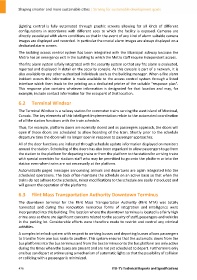Page 486 - Shaping smarter and more sustainable cities - Striving for sustainable development goals
P. 486
Lighting control is fully automated through graphic screens allowing for all kinds of different
configurations in accordance with different uses to which the facility is exposed. Cameras are
directly associated with alarm conditions so that in the event of any kind of alarm suitable camera
images are displayed and recorded. In particular the crucial alarm images are always displayed on a
dedicated alarm screen.
The building access control system has been integrated with the Municipal subway because the
Metro has an emergency exit in the building to which the Metro staff require independent access.
The fire alarm system is fully integrated with the security system so that any fire alarm is evaluated,
reported and displayed in detail on the security console. As this console is part of a network, it is
also available to any other authorized individuals such as the building manager. When a fire alarm
incident occurs this information is made available to the access control system through a listed
interface which then leads to the printing on a dedicated printer of the suitable "response plan".
This response plan contains whatever information is designated for that location and may, for
example, include contact information for the occupant of that location.
6.2 Terminal Windsor
The Terminal Windsor is a railway station for commuter trains serving the west island of Montreal,
Canada. The key elements of this intelligent implementation relate to the automated coordination
of all the station functions with the train schedule.
Thus, for example, platform doors are normally closed and as passengers approach, the doors will
open if those doors are scheduled to allow boarding of the train. Shortly prior to the schedule
departure time the doors will no longer open in response to passenger approaches.
All of the door functions are indicated through schedule update information displayed on monitors
around the station. Scheduling of the doors has also been organized to allow passengers to go from
the station to the platform for departing trains or from the platform to the station for arriving trains
with special overrides for stations staff who may be permitted to go onto the platform or into the
station even when trains are not necessarily at the platform.
Automatically paged messages announcing arrivals and departures are again integrated into the
scheduled operations. The back office maintains the schedule on an active basis so that when the
trains do not adhere to the schedule, minor modifications to the schedule are easily introduced and
will govern the operation of the platforms.
6.3 Flint Mass Transportation Authority Downtown Terminus
The downtown terminal for the Flint Mass Transportation Authority (Flint MTA) was totally
renovated and during this renovation numerous forms of integration and intelligence were
incorporated into this building. The location where the downtown terminus is located is a fairly high
crime area so there are significant concerns related to the security of staff, passengers and vehicles
in the parking lot. Considerable efforts were therefore made to restrict and control any criminal
activities.
A complex interlock system with respect to arriving busses and departing busses allows passengers
to transfer from one bus route to another. This system ensures that the automatic doors from the
bus platforms into the bus terminus and from the bus terminus onto the bus platform are only active
during the times when the buses are present and are not yet scheduled to depart. Furthermore only
one bus can depart at a time using a mechanism of automatic lights so that the possibility of collision
or colliding with a passenger is minimized.
476 ITU‐T's Technical Reports and Specifications

